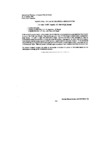Please use this identifier to cite or link to this item:
http://www.alice.cnptia.embrapa.br/alice/handle/doc/12034| Title: | Manipueira: its use in obtaining a biofungicide. |
| Authors: | LIMA, L. P.  CAPALBO, D. M. F.   MELO, I. S. de   MORAES, I. O.   |
| Affiliation: | CAPES; DEISE MARIA FONTANA CAPALBO, CNPMA; ITAMAR SOARES DE MELO, CNPMA; IRACEMA O. MORAES, UNESP. |
| Date Issued: | 1994 |
| Citation: | In: INTERNATIONAL MEETING ON CASSAVA FLOUR AND STARCH, 1994, Cali. Abstracts. Cali: CIAT, 1994. |
| Pages: | p.124 |
| Description: | In the search for an alternative to the intensive use of fungicides in crop production, a soil bacterium was isolated in Guaira, Sao Paulo State (Brazil). This Bacillus gave good control of the fungus Fusarium solani, an important plant disease. In order to apply this bacterium in larger experimental areas, it was necessary to study its production by liquid fermentation on cheap agroindustrial residues. Manipueira (the waste water from cassava flour industry) was the main component of the medium, supplemented by sugarcane molasses. It was inoculated with the Bacillus sp. (isolated from Guaira soil) and incubated under constant agitation and temperatura in 250 ml Erlenmeyer flasks. Bacterial growth, pH and sugar consumption were analyzed over 48 h of fermentation. The results obtained indicated the ability of the residue to support the growth of the strain tested and the importance of scaling up the fermentation process. |
| Thesagro: | Bactéria Mandioca Manipueira Doença Fungo Fusarium Solani Planta Resíduo Solo |
| NAL Thesaurus: | Manihot cassava soil |
| Keywords: | Biofungicide Fungus Residues Plant Disease Control Biofungicida Bacillus thuringienesis Controle Guaíra São Paulo |
| Type of Material: | Resumo em anais e proceedings |
| Access: | openAccess |
| Appears in Collections: | Resumo em anais de congresso (CNPMA)  |
Files in This Item:
| File | Description | Size | Format | |
|---|---|---|---|---|
| 1994PL009CapalboManipueira2659.PDF | 517,76 kB | Adobe PDF |  View/Open |









